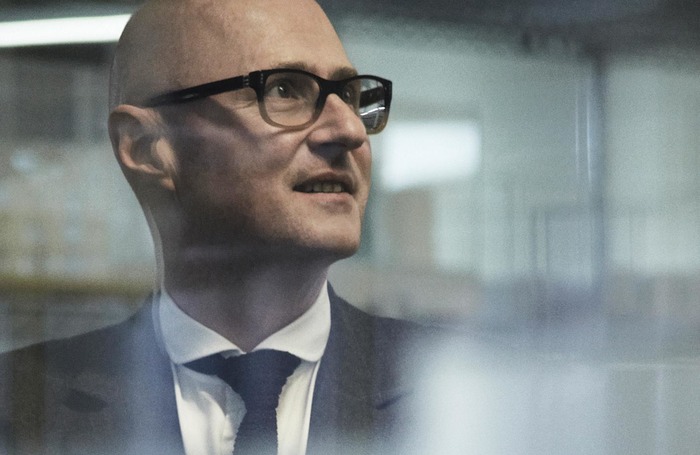Simon Allford is a Founding Partner of AHMM and leads a studio that works in the UK and internationally. He was recently Vice President for Education at the RIBA and a Chair of Design Review at CABE. He explains how focussing on quality of delivery on a variety of projects, together with a clear-eyed business strategy, has made AHMM robust in the face of economic uncertainty.
AHMM and the EU
AHMM was founded in 1989 and is based in London, with other offices in Bristol and Oklahoma. With around 350 staff, the bulk of its work focuses on highly complex, large-scale projects in central London and the company also wins projects elsewhere in the UK, Europe and across the globe.
Approximately 15 to 20% of AHMM’s work is in the EU, outside the UK, with past projects having included a new university in Amsterdam and a large-scale development masterplan in Bratislava. A further 10 to 15% of the practice’s work is derived from other parts of the globe, predominantly the US and India.
The practice employs a multinational workforce with approximately a third of staff originating from the EU; of whom the majority are from Spain, with a number of staff from Portugal, France, Poland, Italy, Romania and Albania.
Allford acknowledges that the UK’s leaving the EU will of course prompt a shift in how the UK and its businesses engages with the rest of the world. He stresses that any response to Brexit-induced challenges must lie in anticipating them and responding proactively to them.

Taking care of business
The business strategy of AHMM is simple and well-defined: focus on the architecture, the quality of what is delivered and charge fees that enable the job to be done properly.
AHMM work across a wide range of sectors. The decision to embrace such a diversity of work has enabled the practice to take advantage of the fact that while there may be slumps in one market, another will always be more buoyant.
‘Avoiding any temptation to develop as a niche practice has also helped the business retain good architects,’ suggests Allford, ‘precisely because they are not constrained to working as specialists in a niche field’.
Another key element of the AHMM strategy is to buck trends and focus on investing in quality: the ‘best thinking’ applied to the ‘best projects’ with good clients. Allford emphasises that the practice talks to clients and contractors all the time, looking to work with successful developers who are constructing better buildings, of the kind that will do well irrespective of any market conditions that Brexit might lead to.
‘There is a very clear allocation of responsibility within the practice,’ Allford explains. The philosophy is to allow architects to focus on what they are good at ‘to keep us at the forefront of the smartest thinking about architecture’, and for other professionals to focus on the other areas of business.
By employing professionals with relevant expertise in these ‘other’ areas of the business including finance, legal, research and HR, the architects within the practice are free to focus on what they do best.
Crucially, this includes having the specialists in place who can bring to the practice an understanding of its staff, how to develop the next generation, why people stay and why they leave.
Achieving ‘Critical Mass’
Allford believes that ‘critical mass’ is an important part of overcoming the challenges brought about by recession or leaving the EU. By pursuing a very deliberate business strategy focusing on the quality of the architecture and charging commensurate fees, AHMM is a business that has achieved it.
With this critical mass comes financial resilience. AHMM have safeguarded their financial security by maintaining financial reserves equating to a quarter of turnover. This policy insulates the practice from the kind of acute pressure that can be brought about by bad debt or fluctuations in the market. Having this level of financial reserves allows the practice to respond to challenges and changes in the market in a measured way.
Fees, investment and collaboration
Allford regards AHMM’s insistence on charging commensurate fees as key to success and a prerequisite for the appropriate involvement in projects. Charging adequate fees buys a firm the necessary time to produce high quality design and provides a platform for investment. AHMM have invested in cutting-edge technology and the employment of specialist staff, including model makers, visualisers, and BIM specialists.
However, Allford takes the view that innovation is not entirely about being at the technological forefront, but also about how the practice works both internally and with other professions. AHMM focuses on creating teams that work collaboratively, both with each other and outside the practice.
‘It’s about the best ideas winning, rather than building up your own personal prestige,’ Allford comments. The practice seeks to work collaboratively with contractors in understanding and tapping into their thinking on ways of speeding up the construction of buildings.
Learning from the past
Allford believes there are strong similarities between architecture today and what the profession was doing fifty years ago. Being mindful of these similarities is important in order to ‘learn the mistakes of the past.’ As such Allford regards the capture and sharing of knowledge within the practice and with those working in wider project teams as a fundamental activity for AHMM and key to its success.
Thanks to Simon Allford, Founding Partner, AHMM.
The RIBA publishes information for practices about Brexit, which is regularly updated, including the likely implications of a no-deal exit.









